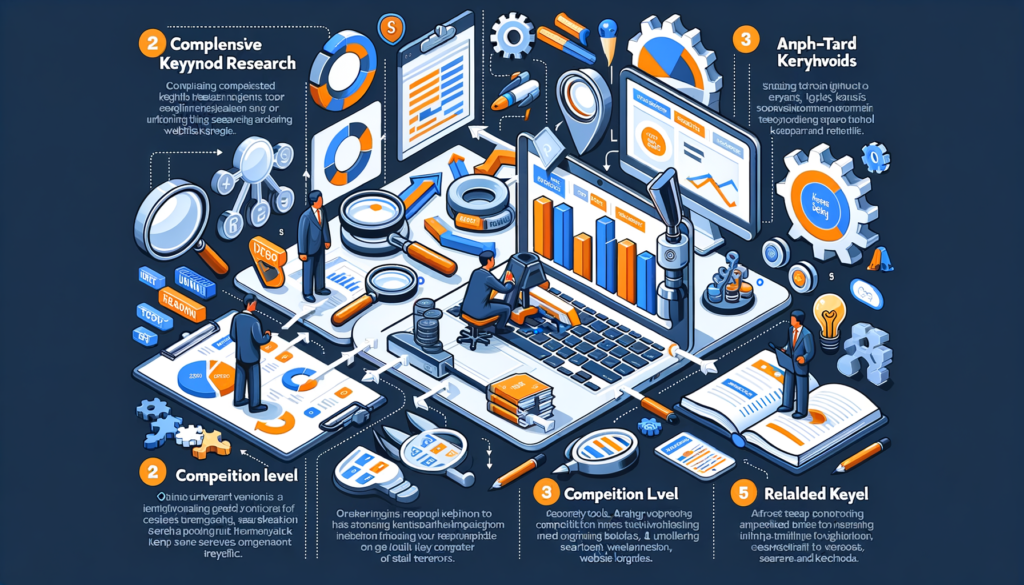Maximizing Your Business Traffic with Powerful SEO Strategies

Are you struggling to attract more visitors to your business website? Search Engine Optimization (SEO) could be the solution you need. By implementing effective SEO strategies, you can increase your website’s visibility on search engine results pages and drive more organic traffic to your business. In this blog post, we will explore the various ways in which SEO can help your business attract and retain valuable website traffic. Whether you’re a small startup or a well-established company, understanding the power of SEO is crucial for sustainable growth and success in the digital landscape.
What is SEO and Why Does it Matter for Your Business?
Search Engine Optimization (SEO) is the practice of optimizing your website to improve its visibility and rankings on search engine results pages. This is achieved through various strategies and techniques that help search engines recognize and recommend your site to users. SEO is crucial for businesses in today’s digital landscape, as it directly impacts online visibility, organic traffic, and ultimately, revenue.
Breaking Down SEO
SEO involves optimizing your website’s content, structure, and performance to meet the criteria set by search engines like Google, Bing, and others. This includes keyword research, content optimization, technical optimizations, and link building, among other factors. By conforming to search engine guidelines and best practices, businesses can enhance their online presence and attract quality traffic.

The Power of Search Engines in Today’s Market
Search engines are the gateway to the internet for most users. When people have questions or are looking for products or services, they turn to search engines for answers. Google, in particular, dominates the search market, making it essential for businesses to align with its algorithms and ranking factors. This ensures that their websites are visible to potential customers who are actively searching for what they offer.
Search engines have become ingrained in daily life, with users relying on them for information, solutions, and recommendations. Understanding and leveraging the power of search engines through SEO is fundamental for businesses aiming to thrive in the digital realm.
Unpacking the Core Components of SEO
When it comes to driving traffic to your business, understanding the core components of SEO is essential. These components include keywords, on-page SEO, and off-page SEO, each playing a crucial role in improving your website’s search engine rankings.
Keywords
Choosing the right keywords is fundamental to SEO success. Keywords are the terms and phrases that users enter into search engines, and they form the foundation of your content. By conducting thorough keyword research, you can identify the terms your target audience is using and strategically incorporate them into your website’s content.
Utilizing long-tail keywords and considering user intent when selecting keywords can significantly impact your visibility in search results. It’s important to integrate keywords naturally into your content, avoiding keyword stuffing, to ensure a positive user experience and maintain the quality of your material.
On-Page SEO
On-page SEO, also known as content SEO, focuses on optimizing individual pages to enhance their relevance and visibility. This involves strategic placement of keywords, compelling meta descriptions, and well-structured content that provides value to your audience.
Creating comprehensive and engaging content that aligns with search intent is crucial for on-page SEO. Utilize headings, subheadings, and meta tags effectively to signal the relevance of your content to search engines. Additionally, internal linking within your website can strengthen the authority of specific pages and improve overall user experience.
Off-Page SEO
While on-page SEO focuses on optimizing your website’s content, off-page SEO revolves around external factors, particularly link building. Acquiring high-quality backlinks from reputable sources signals to search engines that your website is a valuable and authoritative resource.
Engaging in outreach and developing relationships with industry-relevant websites can lead to natural link acquisition, bolstering your off-page SEO efforts. Additionally, creating shareable content that resonates with your audience can increase the likelihood of earning valuable backlinks.
In summary, by mastering the core components of SEO, including keywords, on-page SEO, and off-page SEO, you can lay a strong foundation for driving organic traffic to your business and improving your online visibility. Understanding and implementing these components effectively can contribute to the long-term success of your SEO strategy.

Strategic Keyword Research to Target Potential Customers
Before diving into the world of SEO, it’s crucial to lay a solid foundation through strategic keyword research. This process involves identifying the specific words and phrases potential customers are using to search for products or services similar to what your business offers. Effective keyword research enables you to understand the language of your target audience, allowing you to tailor your online content to their needs and preferences.
Tools and Techniques for Effective Keyword Research
To conduct comprehensive keyword research, utilizing advanced tools such as Google Keyword Planner, SEMrush, or Ahrefs can provide valuable insights into search volume, competition level, and related keywords. These tools allow you to identify high-performing keywords and assess their potential impact on your website’s traffic. Additionally, leveraging techniques like brainstorming, analyzing competitor keywords, and exploring long-tail keywords can further enhance the scope of your research, uncovering hidden opportunities for optimization.

Understanding User Intent for Better Keyword Selection
Beyond the basic identification of relevant keywords, it’s essential to delve into the psychology of user intent. By understanding why users are searching for specific terms, you can align your content more precisely with their needs. Are they looking for information, seeking to make a purchase, or comparing options? Tailoring your keyword selection to align with user intent can significantly impact the quality of traffic driven to your website, resulting in higher conversion rates and overall engagement.

On-Page SEO Tactics that Increase Visibility
Before delving into off-page SEO techniques, it’s essential to optimize your website for search engines and users through on-page strategies. Here’s how to enhance your digital presence:
Optimizing Content for Both Users and Search Engines

Crafting content that resonates with your target audience while aligning with search engine algorithms is pivotal for driving organic traffic. Leverage relevant keywords naturally within your content to cater to both user intent and search engine crawlers. Additionally, employing descriptive meta titles and engaging meta descriptions can entice users to click through to your site from search engine results pages.
The Importance of Mobile Optimization

With the increasing prevalence of mobile browsing, ensuring that your website is optimized for mobile devices is non-negotiable. Responsive design, fast loading times, and easy navigation on mobile platforms are critical for delivering a seamless user experience. Prioritizing mobile optimization not only enhances user satisfaction but also aligns with search engine ranking criteria, as mobile-friendliness is a significant ranking factor.
Enhancing Load Speeds to Keep Visitors Engaged
A swift website load speed is imperative for retaining visitors and reducing bounce rates. Implementing optimization techniques such as compressing images, minifying CSS and JavaScript, leveraging browser caching, and utilizing content delivery networks (CDNs) can significantly enhance load speeds. By providing a snappy and seamless browsing experience, you can captivate users and encourage prolonged site exploration.
By implementing these on-page SEO tactics, you can bolster your website’s visibility, attract organic traffic, and pave the way for off-page strategies to amplify your digital footprint.
Off-Page SEO Strategies to Strengthen Your Brand
In the digital landscape, off-page SEO strategies play a crucial role in enhancing a brand’s online visibility and driving organic traffic. These strategies extend beyond the confines of your website and encompass various external factors that contribute to your site’s authority and relevance in the eyes of search engines.
The Role of Backlinks in SEO Success
Backlinks serve as the currency of the internet, representing endorsements from other websites. They are essential for SEO success as search engines view them as signals of credibility and trustworthiness. Quality backlinks from reputable websites can significantly boost your website’s search engine ranking, making it crucial to cultivate a diverse and natural backlink profile. By earning backlinks from authoritative sources, you can strengthen your website’s authority and attract more organic traffic.

Social Media Signals and Their Impact on SEO
Social media signals, including likes, shares, and comments, can also influence your website’s SEO performance. Engaging content that resonates with your social media audience can lead to increased visibility and referral traffic. While social media signals may not have a direct impact on search engine rankings, they contribute to brand exposure and can lead to the acquisition of natural backlinks from authoritative sources. Integrating social media marketing into your SEO strategy can amplify your brand’s online reach and foster a community of engaged users.

Leveraging Local SEO to Attract Nearby Customers
For businesses targeting local customers, optimizing for local SEO is paramount. With the increasing prevalence of “near me” searches, ensuring your business appears in local search results is essential for attracting nearby customers. This involves optimizing your website with local keywords, obtaining positive reviews on platforms like Google My Business, and ensuring consistent business information across online directories. Embracing local SEO tactics can bolster your visibility within your community and drive foot traffic to your physical location.

Content is King: Creating Valuable and Relevant Content
In the digital marketing realm, the phrase “Content is King” holds true. The creation of valuable and relevant content is pivotal in driving organic traffic to your business website. By consistently producing high-quality content, you can establish your brand as an authoritative source and enhance your website’s visibility in search engine results.
Blog Posts and Articles
Crafting insightful and informative blog posts and articles provides a platform for conveying your expertise to your target audience. By addressing common pain points, offering solutions, and sharing valuable insights, you can captivate and engage your readers. Well-structured blog posts also contribute to a positive user experience and can lead to increased time spent on your site, a crucial metric in SEO.
Multimedia Content
Incorporating multimedia elements such as engaging videos, infographics, and interactive tools further enriches the user experience. Visual content has the potential to convey complex information in a digestible format, making it highly shareable and capable of attracting a wider audience. Additionally, multimedia content adds diversity to your website, catering to varying user preferences and enhancing overall engagement.

By consistently producing valuable and relevant content in the form of blog posts, articles, and multimedia, you can effectively enhance your website’s visibility and attract organic traffic, contributing to the overall success of your business.
Monitoring SEO Performance and Making Adjustments
Are you curious about how your SEO efforts are paying off? Monitoring SEO performance is crucial for gaining insights into the effectiveness of your strategies and making necessary adjustments. Let’s delve into essential SEO metrics to track regularly and explore the importance of adapting to SEO changes and algorithm updates.
Essential SEO Metrics to Track Regularly
Gauging the success of your SEO endeavors requires the consistent tracking of key performance indicators. These metrics include organic traffic, keyword rankings, click-through rates, bounce rates, and conversion rates. Understanding these metrics provides a comprehensive view of your website’s performance on search engines and aids in identifying areas that need improvement.
Tracking organic traffic helps in evaluating the volume and quality of visitors coming to your site through search results. Keyword rankings offer insights into how well your content is positioned in search engine results pages, indicating the effectiveness of your keyword targeting. Click-through rates and bounce rates provide valuable data on user engagement, while conversion rates signal the impact of SEO efforts on generating leads or sales.
Adapting to SEO Changes and Algorithm Updates
The realm of SEO is dynamic, with search engines frequently updating their algorithms to deliver more relevant and valuable results to users. Staying abreast of these changes and adapting your SEO strategies is paramount for maintaining and improving organic search visibility.
Adaptation involves keeping an eye on industry trends, algorithm updates, and competitors’ strategies. Adhering to best practices and implementing changes to align with evolving search engine algorithms ensures that your website continues to rank well and remains competitive in the digital landscape.
Incorporating the latest SEO techniques and adjusting your approach based on algorithm updates positions your business to thrive in the ever-evolving online ecosystem.

SEO Pitfalls to Avoid
Navigating the world of SEO can be challenging, especially given the ever-changing landscape of search engine algorithms. To ensure success, it’s crucial to steer clear of common pitfalls that could impede your SEO efforts and harm your website’s rankings.
Common SEO Mistakes That Could Harm Your Rankings
Making mistakes in SEO can negatively impact your website’s visibility and organic traffic. Some common errors to avoid include keyword stuffing, neglecting to optimize for mobile, ignoring meta descriptions and title tags, and using irrelevant or low-quality backlinks. It’s essential to prioritize user experience, create high-quality, relevant content, and adhere to best practices for on-page and off-page optimization to maintain a strong SEO foundation.

Navigating SEO Myths and Misconceptions
In the SEO world, myths and misconceptions abound, leading to confusion and potentially harmful actions. It’s crucial to debunk these myths and stay informed about the latest best practices. Some common SEO myths include the belief that keyword density is the most critical factor for rankings, the notion that meta tags are no longer relevant, and the misconception that SEO is a one-time task. By staying updated with reliable sources and industry experts, businesses can navigate through the misinformation and implement effective and sustainable SEO strategies.
Remember, avoiding these SEO pitfalls will help you establish a strong foundation for your website’s visibility and ultimately drive more traffic and potential customers to your business.
Conclusion
In conclusion, SEO is a powerful tool for driving traffic to your business. By optimizing your website and content for search engines, you can improve your visibility and attract more potential customers. A well-executed SEO strategy can lead to increased organic traffic, higher conversion rates, and ultimately, improved business growth. Keep in mind that SEO is an ongoing process that requires continuous effort and adaptation to stay ahead of the competition. Embracing SEO as a fundamental aspect of your marketing efforts will undoubtedly yield long-term benefits for your business.







